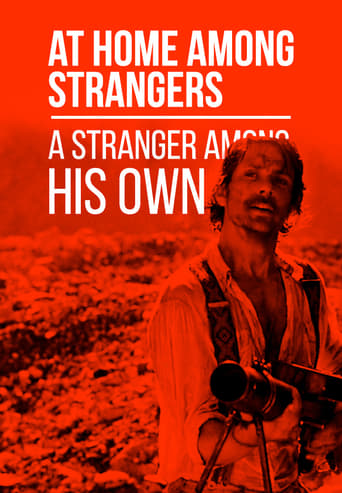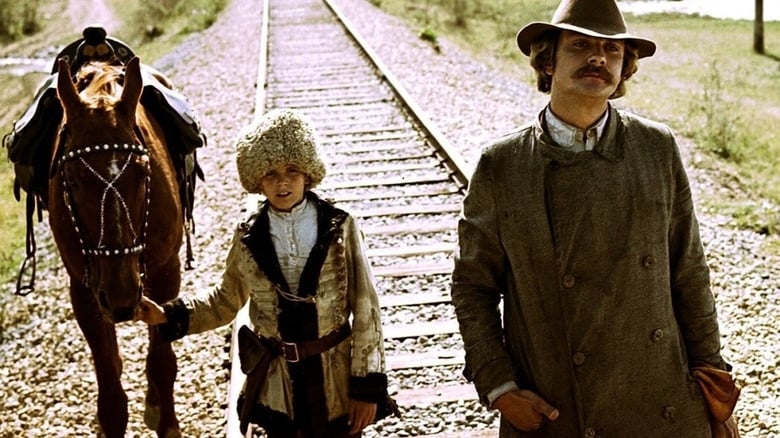At Home Among Strangers, a Stranger Among His Own (1974)
Following the Russian Civil War, a loyal Red, Shilov, must prove he is at home among strangers as he attempts to recapture a shipment of gold that he was supposed to deliver to Moscow. Needed as a means of buying food for the people, the gold Shilov was entrusted with is stolen, initially by a group of assassins and then by a group of bandits. In tracking the gold’s whereabouts, Shilov’s motives are questioned and he is suspected of treason, in part because his brother was a devoted White. In an effort to clear his name, Shilov locates the gold, but he also discovers rampant greed and corruption.
Watch Trailer
Free Trial Channels
Cast


Reviews
From my favorite movies..
Excellent, a Must See
Very interesting film. Was caught on the premise when seeing the trailer but unsure as to what the outcome would be for the showing. As it turns out, it was a very good film.
It is neither dumb nor smart enough to be fun, and spends way too much time with its boring human characters.
Set in the 1920's shortly after the end of the Russian civil war and released on 1974 during the Brezhnev era, at home Among Strangers, Stranger at Home is an action film that lives up to its genre and also manages to develop a more complex storyline than other action films that just focus their attention towards gruesome fight scenes. The scenes in which fighting did occur were much less graphic but still just as affective on eliciting the same level of excitement that is characteristic of an action film. During these scenes the movie is very reminiscent of American action films which depict western cowboy lifestyle.The story itself deals with the character Shilov who is accused of treason after a precious shipment gets stolen under his watch and he gets framed for it. From the very start, the films images were particularly striking both cinematically and psychologically. The different settings of this intro which included a countryside (common for this point in time) and a small living area, all captured my attention immediately. The intro alone initiated a large list of questions with its seeming randomness. Such as why are they yelling and dancing? Or Why did they just push that carriage down the hill? What is strategically communicated through this intro despite the lack of dialogues is the character's deep bond with each other and their emerging friendship. There are many other scenes later on in the movie that may seem random but serve a purpose to further convey these ideas of forged bonds. One such scene is when the train robbers are all jubilant after having stolen the gold. Through the different uses of genius cinematographically placed supporting scenes this film ended up being more than just a plain action movie. The character development was phenomenal and the action scenes ended up being one of its main attributes.
a Nikita Mikhalkov. with each of elements who defines his work - humor, heroism, sacrifice, justice, melancholic crumbs. a kind of Eastern on the young Soviet Union construction. but out of political circle. because it is only a story. about duty, trust, friendship and profound truth. and not that bricks are fundamental but the manner to present it. with subtle irony, delicacy and a fine Russian style. a film about justice and a hero with has not ambition to be more than a common man. an interesting performance and few splendid images. and special atmosphere. is it enough ? is it too much ? it is just a pure Mikhalkov movie. ant this fact is only essential.
At Home Among Strangers, a Stranger Among his Own is a rollicking action and adventure film that nonetheless calls attention to deeply important themes in Russian history. Set directly after the Russian Civil War, the film looks and feels very much like an American Western, embodying motifs of greed, justice, honor, and betrayal. In the film, a shipment of gold being sent to Moscow for the purchase of food supplies is intercepted by a band of train robbers, who are themselves infiltrated by a Red veteran–accused of trying to steal the gold–out to see justice done and clear his name, and by the murderous villain who framed him. Meanwhile, the local Cheka attempts to solve the crime, leading to numerous chases and gunfights. Along with the action and suspense that drive the film's plot, At Home Among Strangers explores the challenges in Russia following the Red victory over the Whites. After the war, an entirely new struggle of rebuilding a divided country begins. The film showcases victorious but overwhelmed reds, defeated but still greedy Whites, and bandits surviving however they can, bearing no political or ideological affiliation. The chairman of the Cheka embodies the struggle of uniting a country made up of such disparate factions; he struggles to do everything that must be done to transition from wartime to socialist peace. Likewise, a former cavalry officer grapples with settling finances, doing his part for peacetime when the battlefield is all he knows. Finally, demonstrating the fundamental divisions within Russian society, the hero Shilov struggles to retain the trust of his fellows, who know that his brother fought for the White army. Stylistically, this "ostern" pays homage not only to the popular American cinema it emulates, but also to previous triumphs of Russian film. A scene in which machine guns are fired from atop cliffs at the water below recalls the final minutes of the Vasilyev Brothers' Chapaev, and some scenes in the movie, like flashes of comrades-in-arms celebrating their victory amid feelings of betrayal, and an image of a wagon tumbling down a hill as the exhausted Shilov makes his way down a similar decline to his waiting comrades, are unmistakable nods to the montage style made famous by Eisenstein and his contemporaries. When the gold is finally returned and old friends regain their mutual trust, shots of the men celebrating the end of the war are interspersed with those of them celebrating the safe return of their valuables. Ironically, their glee over the gold is matched only by the joy they had taken in their victory over such material possessions, and the superimposition serves to remind audiences that now, even amid all their struggles, wealth and camaraderie go hand in hand, and that hard-earned gains are for the benefit of all.
This is a great movie. It reminds me a little bit of "Beloye Solntse Pustini" or in English "The White Sun of the Desert", same type of the 1920's action movie. I think this movie has some of the best cinematography that I have ever seen in any film. This is a very easy going-enjoyable-smart action film. Mikhalkov did a great job.








